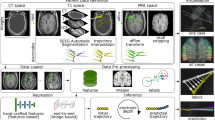Abstract
Purpose
Stereoelectroencephalography (SEEG) is a minimally invasive surgical procedure, used to locate epileptogenic zones. An accurate identification of the metallic contacts recording the SEEG signal is crucial to ensure effectiveness of the upcoming treatment. However, due to the presence of metal, post-operative CT scans contain strong streak artefacts that interfere with deep learning segmentation algorithms and require a lot of training data to distinguish from actual contacts. We propose a method to generate synthetic data and use them to train a neural network to precisely locate SEEG electrode contacts.
Methods
Random electrodes were generated following manufacturer’s specifications and dimensions and placed in acceptable regions inside metal-free CT images. Metal artefacts were simulated in the generated data set using radon transform, beam hardening, and filtered back projection. A UNet neural network was trained for the contacts segmentation task using various training set-ups combining real data, basic augmented data, and synthetic data. The results were compared.
Results
We reported a higher accuracy when including synthetic data during the network training, while training only on real and basic augmented data more often led to misclassified artefacts or missed contacts. The network segments post-operative CT slices in less than 2 s using 4 GeForce RTX2080 Ti GPUs and in under a minute using a standard PC with GeForce GTX1060.
Conclusion
Using synthetic data to train the network significantly improves contact detection and segmentation accuracy.





Similar content being viewed by others
References
Scheffer IE, Berkovic S, Capovilla G, Connolly MB, French J, Guilhoto L, Hirsch E, Jain S, Mathern GW, Moshé SL, Nordli DR, Perucca E, Tomson T, Wiebe S, Zhang Y-H, Zuberi SM (2017) ILAE classification of the epilepsies: position paper of the ILAE commission for classification and terminology. Epilepsia 58(4):512–521
Talairach J, Bancaud J (1966) Lesion,“ irritative ” zone and epileptogenic focus. Stereo Funct Neurosurg 27(1–3):91–94
Minotti L, Montavont A, Scholly J, Tyvaert L, Taussig D (2018) Indications and limits of stereoelectroencephalography (SEEG). Neurophysiol Clinique 48(1):15–24
Meesters S, Ossenblok P, Colon A, Schijns O, Florack L, Boon P, Wagner L, Fuster A (2015) Automated identification of intracranial depth electrodes in computed tomography data. In: IEEE 12th international symposium on biomedical imaging (ISBI), pp 976–979
Narizzano M, Arnulfo G, Ricci S, Toselli B, Tisdall M, Canessa A, Fato M, Cardinale F (2017) SEEG assistant: a 3DSlicer extension to support epilepsy surgery. BMC Bioinf 18:124
Granados A, Vakharia V, Rodionov R, Schweiger M, Vos S, O’Keeffe A, Li K, Wu C, Miserocchi A, Mcevoy A, Clarkson M, Duncan J, Sparks R, Ourselin S (2018) Automatic segmentation of stereoelectroencephalography (SEEG) electrodes post-implantation considering bending. Int J Comput Assist Radiol Surg 13:935–946
Benadi S, Ollivier I, Essert C (2018) Comparison of interactive and automatic segmentation of stereoelectroencephalography electrodes on computed tomography post-operative images: preliminary results. Healthcare Technol Lett 5(5):215–220
Pantovic A, Ollivier I, Essert C (2022) 2D and 3D-UNet for segmentation of SEEG electrode contacts on post-operative CT scans. In: Proceedings of medical imaging: visualization and image-guided procedures (to appear)
Chilamkurthy S, Ghosh R, Tanamala S, Biviji M, Campeau NG, Venugopal VK, Mahajan V, Rao P, Warier P (2018) Deep learning algorithms for detection of critical findings in head CT scans: a retrospective study. Lancet 392(10162):2388–2396
Mullin JP, Shriver M, Alomar S, Najm I, Bulacio J, Chauvel P, Gonzalez-Martinez J (2016) Is SEEG safe? A systematic review and meta-analysis of stereoelectro-encephalography-related complications. Epilepsia 57(3):386–401
Kikinis R, Pieper SD, Vosburgh KG (2014) 3D Slicer:A platform for subject-specific image analysis, visualization, and clinical support. In: Intraoperative imaging and image-guided therapy. Springer, New York, pp 277–289
Suzuki S, be K (1985) Topological structural analysis of digitized binary images by border following. Comput Vis Graphics Image Process 30(1):32–46
Boas FE, Fleischmann D (2012) CT artifacts: causes and reduction techniques. Imag Med 4(2):229–240
Mehrania, A, Ay M, Rahmim A, Zaidi H (2011) Sparsity constrained sinogram inpainting for metal artifact reduction in x-ray computed tomography. In: IEEE symposium on nuclear science, pp 3694–3699
Zhang Y, Yu H (2018) Convolutional neural network based metal artifact reduction in X-ray computed tomography. IEEE Trans Med Imag 37(6):1370–1381
Yu L, Zhang Z, Li X, Xing L (2020) Deep sinogram completion with image prior for metal artifact reduction in CT images. IEEE Trans Med Imag 40(1):228–238
Megherbi N, Breckon T.P, Flitton G.T, Mouton A (2013) Radon transform based automatic metal artefacts generation for 3D threat image projection. In: Optics and photonics for counterterrorism, crime fighting and defence IX; and optical materials and biomaterials in security and defence systems technology X, vol 8901. International Society for Optics and Photonics, SPIE, pp 94–102
De Man B, Nuyts J, Dupont P, Marchal G, Suetens P (1999) Metal streak artifacts in x-ray computed tomography: a simulation study. IEEE Trans Nucl Sci 46(3):691–696
Palenstijn WJ, Batenburg KJ, Sijbers J (2013) The astra tomography toolbox. In: 13th International conference on computational and mathematical methods in science and engineering, pp 1139–1145
Ronneberger O, Fischer P, Brox T (2015) U-net: Convolutional networks for biomedical image segmentation. In: Medical image computing and computer-assisted intervention. Springer, pp 234–241
Funding
This work was supported by ArtIC “Artificial Intelligence for Care” grant (ANR-20-THIA-0006-01), co-funded by Région Grand Est, Inria Nancy - Grand Est, IHU Strasbourg, University of Strasbourg and University of Haute-Alsace, France.
Author information
Authors and Affiliations
Corresponding author
Ethics declarations
Conflict of interest
The authors have no conflict of interest to declare.
Ethics approval
This research study was conducted retrospectively from anonymised data, in accordance with the ethical standards of our institution and with the 1964 Declaration of Helsinki and its later amendments or comparable ethical standards.
Informed consent
Informed consent was obtained from all individual participants included in the study.
Additional information
Publisher's Note
Springer Nature remains neutral with regard to jurisdictional claims in published maps and institutional affiliations.
Rights and permissions
About this article
Cite this article
Pantovic, A., Ren, X., Wemmert, C. et al. Generation of synthetic training data for SEEG electrodes segmentation. Int J CARS 17, 937–943 (2022). https://doi.org/10.1007/s11548-022-02585-4
Received:
Accepted:
Published:
Issue Date:
DOI: https://doi.org/10.1007/s11548-022-02585-4




